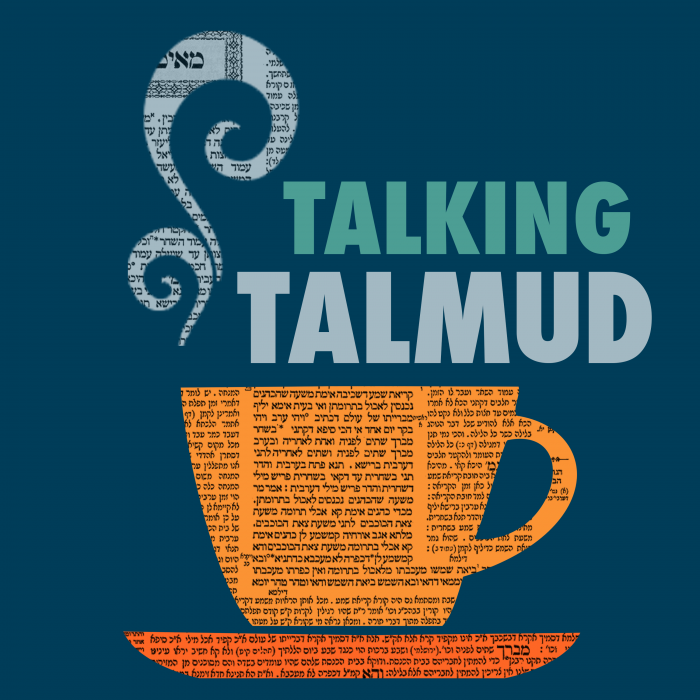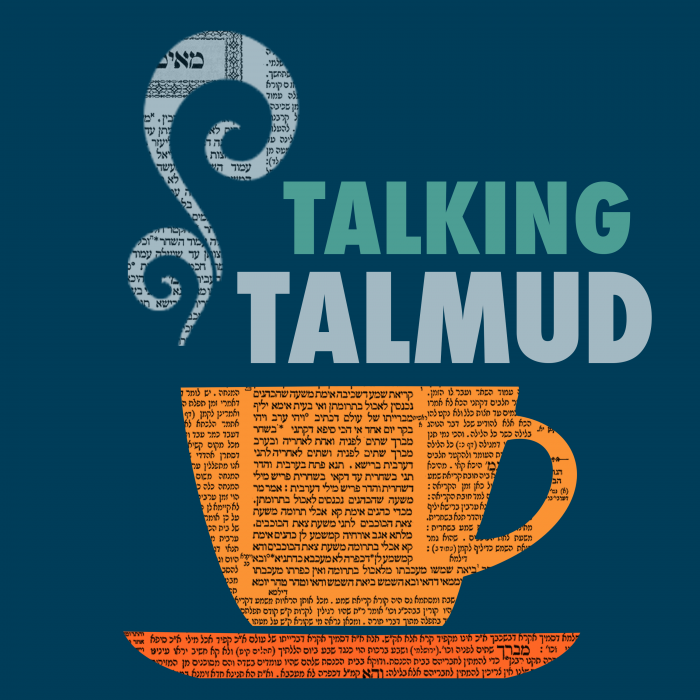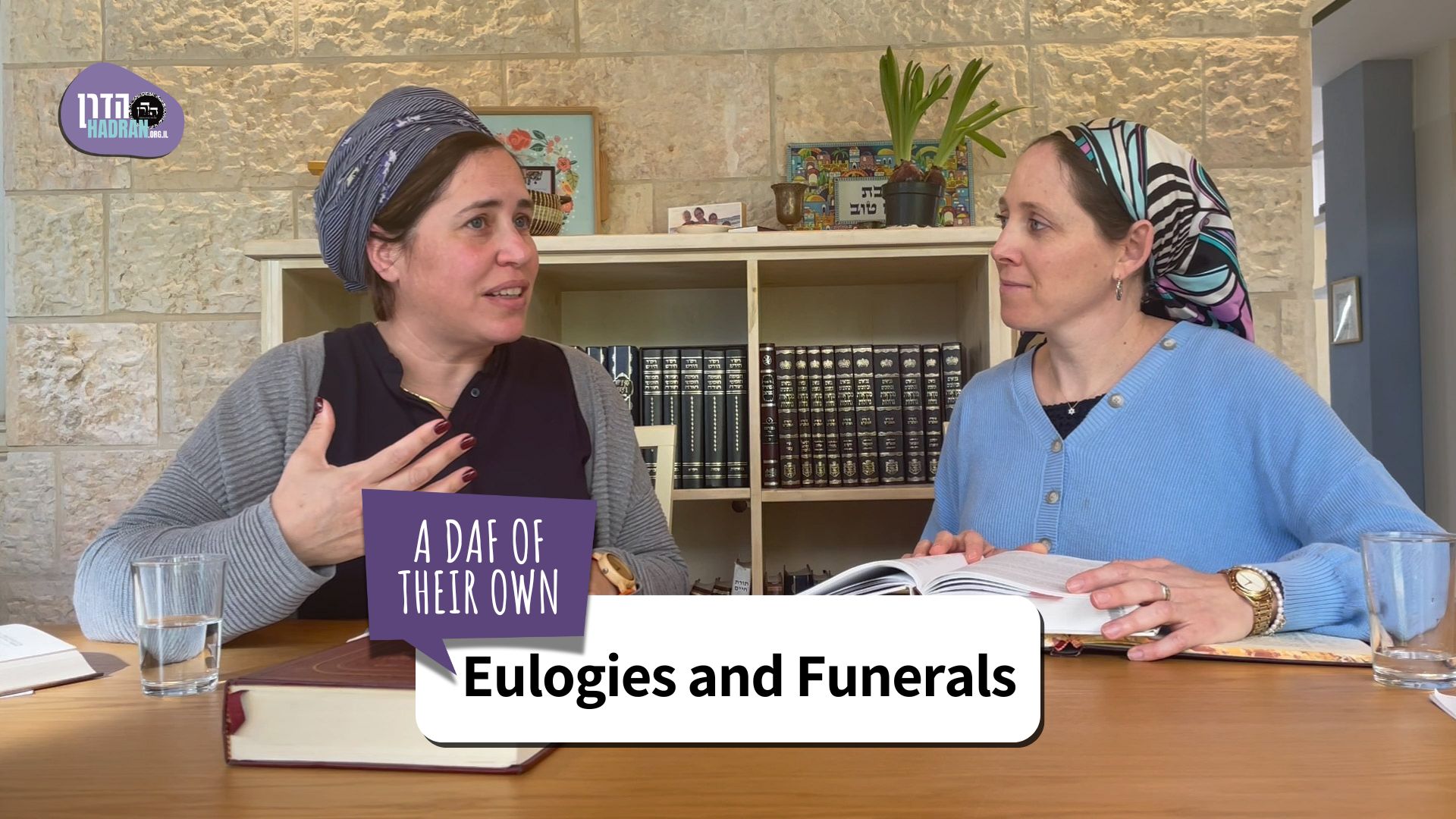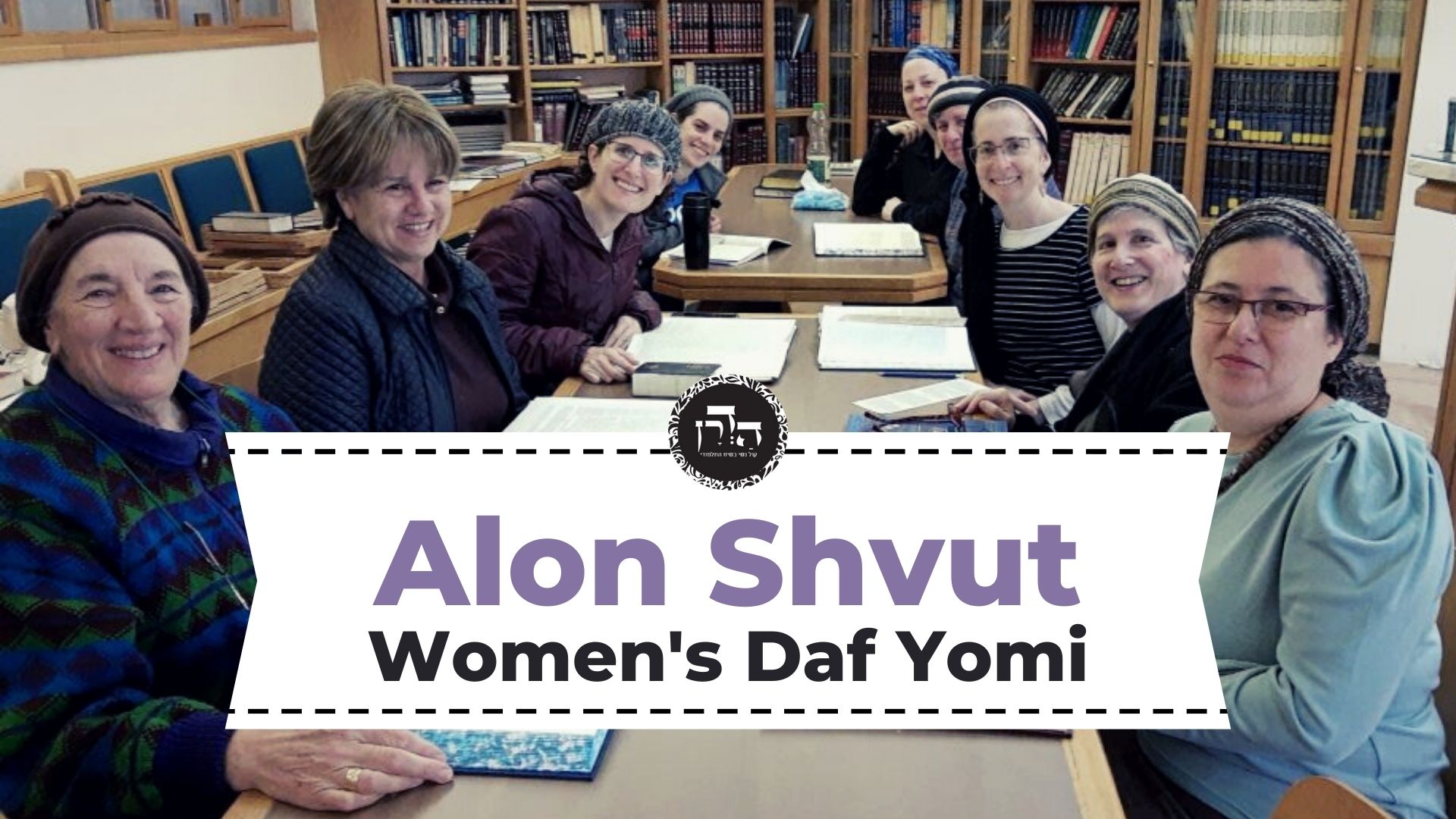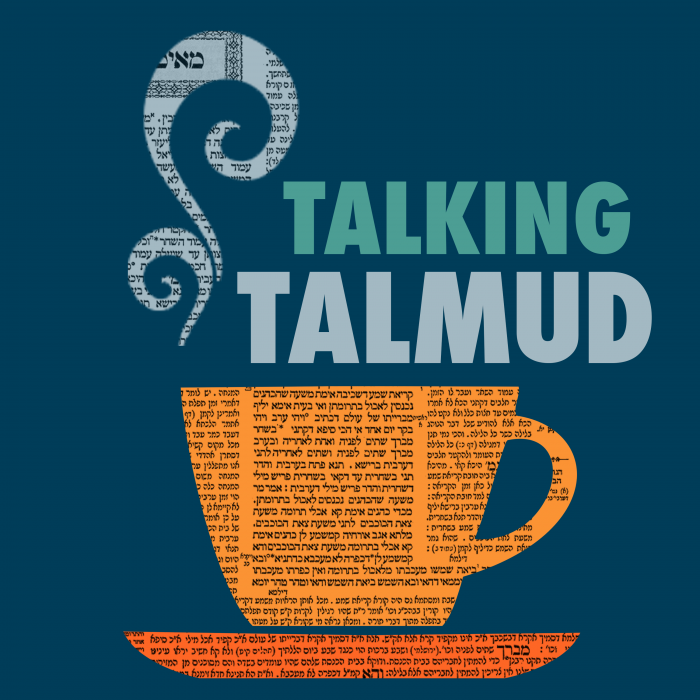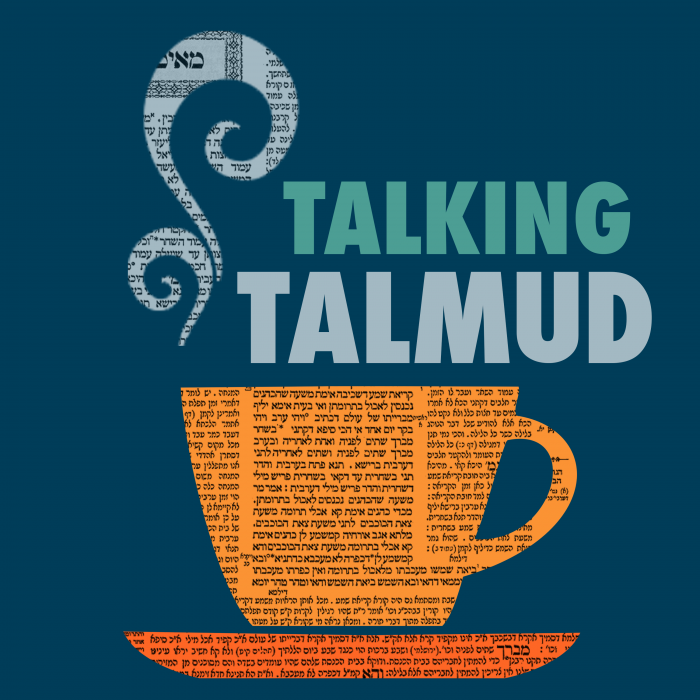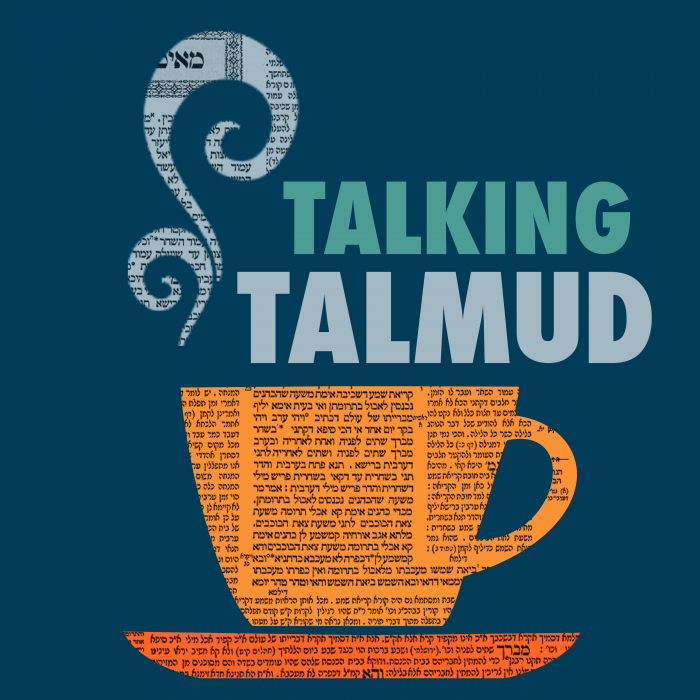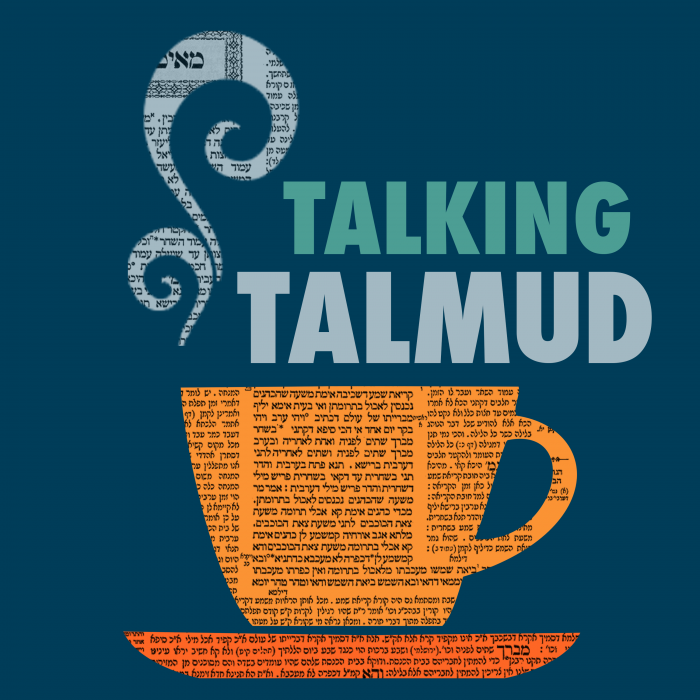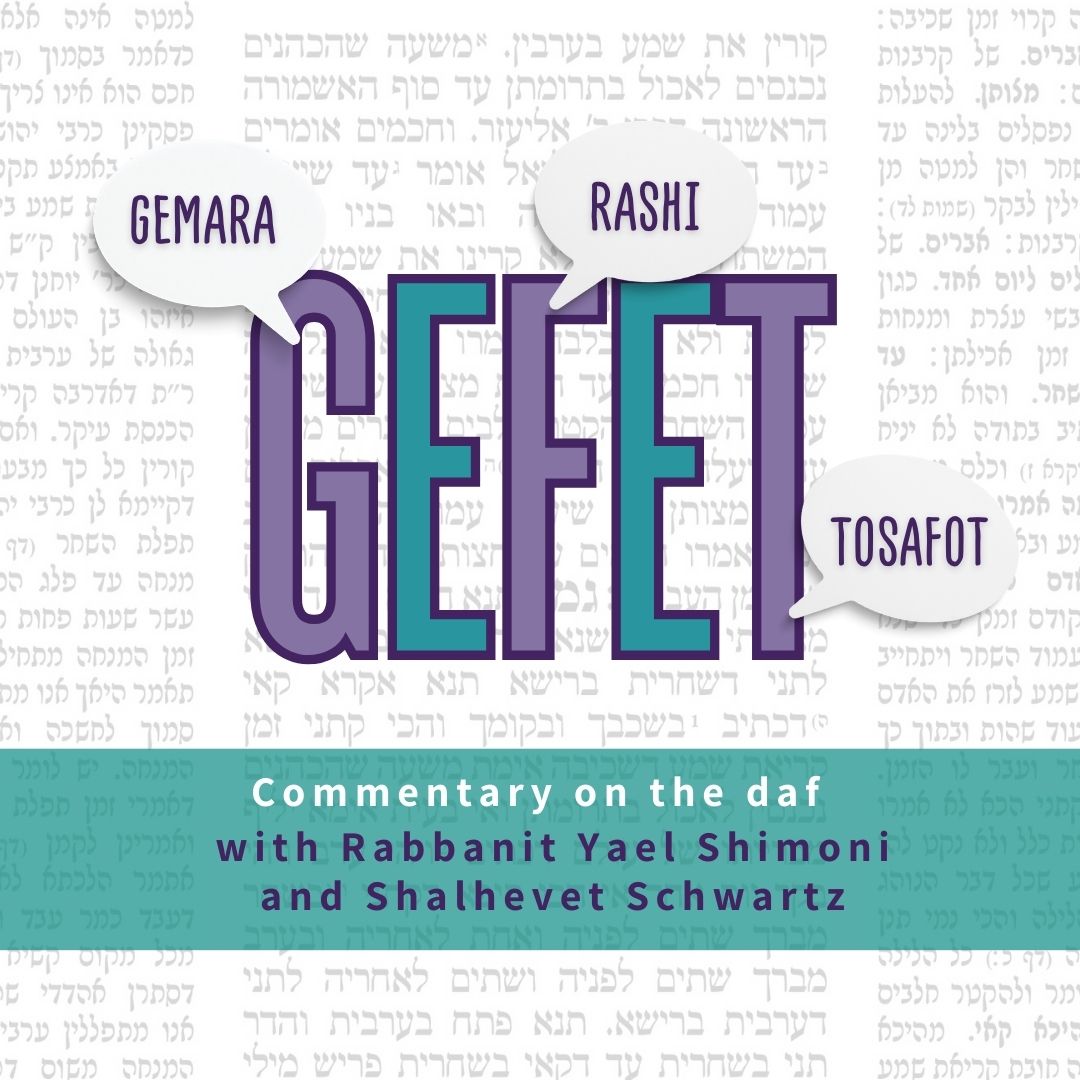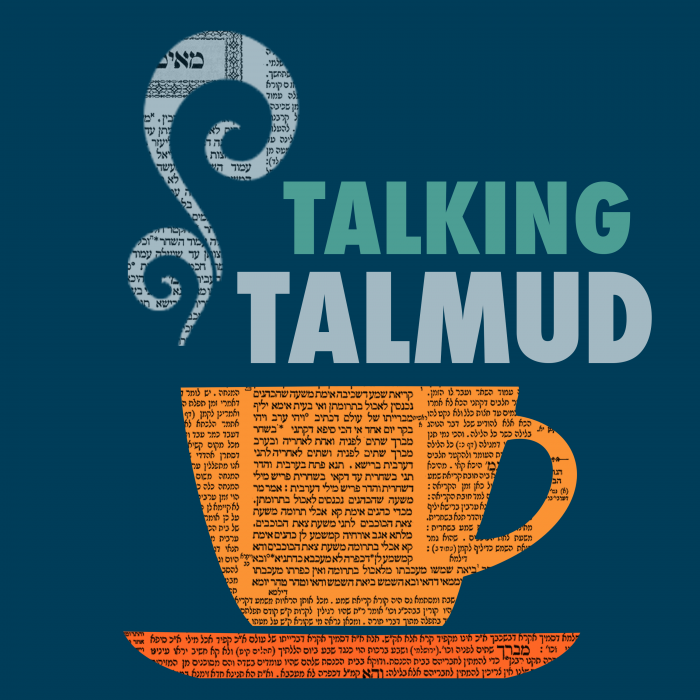The mishna describes the slaughtering of the daily tamid sacrifice through sprinkling of the blood, flaying the hide, cutting its body into parts and the procession of priests carrying it to the ramp of the altar.
This week’s learning is sponsored by Robert and Paula Cohen in loving memory of Joseph Cohen, Yosef ben Moshe HaCohen, z”l. “He was hard working, loved to sing, esp. as a chazan, and was very dedicated to his family and community.”
Want to dedicate learning? Get started here:


Today’s daily daf tools:
This week’s learning is sponsored by Robert and Paula Cohen in loving memory of Joseph Cohen, Yosef ben Moshe HaCohen, z”l. “He was hard working, loved to sing, esp. as a chazan, and was very dedicated to his family and community.”
Today’s daily daf tools:
Delve Deeper
Broaden your understanding of the topics on this daf with classes and podcasts from top women Talmud scholars.
New to Talmud?
Check out our resources designed to help you navigate a page of Talmud – and study at the pace, level and style that fits you.
The Hadran Women’s Tapestry
Meet the diverse women learning Gemara at Hadran and hear their stories.
Tamid 31
לֹא הָיָה שׁוֹבֵר בּוֹ אֶת הָרֶגֶל, אֶלָּא נוֹקְבוֹ מִתּוֹךְ עַרְקוּבּוֹ, וְתוֹלֶה בּוֹ.
When the priest flayed the hide of the daily offering after its slaughter, he would not break the animal’s leg in the typical manner of flaying an animal; rather, he punctures the leg from within each knee of the hind leg and suspends the animal by placing these holes on two hooks, in order to flay the animal’s hide.
הָיָה מַפְשִׁיט וְיוֹרֵד עַד שֶׁמַּגִּיעַ לֶחָזֶה. הִגִּיעַ לֶחָזֶה, חָתַךְ אֶת הָרֹאשׁ, וּנְתָנוֹ לְמִי שֶׁזָּכָה בּוֹ. חָתַךְ אֶת הַכְּרָעַיִם, וּנְתָנָן לְמִי שֶׁזָּכָה בָּהֶן. מֵרַק אֶת הַהֶפְשֵׁט. קָרַע אֶת הַלֵּב וְהוֹצִיא אֶת דָּמוֹ.
The priest began flaying from the top of the inverted animal, descending until he would reach the hide of the breast. Once he reached the breast, he severed the lamb’s head and gave it to the priest who won the right to take it up to the ramp. Next he severed the four legs below the knee and gave them to the priest who won the right to take them up to the ramp. He completed the flaying of the remaining hide from the breast down, and then the priest cut the heart and drained its blood.
חָתַךְ אֶת הַיָּדַיִם, וּנְתָנָן לְמִי שֶׁזָּכָה בָּהֶן. עָלָה לָרֶגֶל הַיְמָנִית, חֲתָכָהּ, וּנְתָנָהּ לְמִי שֶׁזָּכָה בָּהּ, וּשְׁתֵּי בֵּיצִים עִמָּהּ. קְרָעוֹ, וְנִמְצָא כּוּלּוֹ גָּלוּי לְפָנָיו.
Next the priest severed the remaining upper parts of the forelegs and gave them to the priest who won the right to take them up to the ramp. Afterward he moved up to the remaining upper part of the right hind leg, severed it, and gave it to the priest who won the right to take it up to the ramp; and the animal’s two testicles were cut along with the right leg, leaving the animal suspended by its left hind leg. Then the priest tore open the animal’s midsection, resulting in the innards of the entire animal being exposed before him.
נָטַל אֶת הַפֶּדֶר, וּנְתָנוֹ עַל בֵּית שְׁחִיטַת הָרֹאשׁ מִלְּמַעְלָה. נָטַל אֶת הַקְּרָבַיִים, וּנְתָנָן לְמִי שֶׁזָּכָה בָּהֶן, לַהֲדִיחָן. וְהַכָּרֵס מְדִיחִין אוֹתָהּ בְּבֵית הַמְּדִיחִין. וּמְדִיחִין אוֹתָהּ כׇּל צׇרְכָּהּ, וְהַקְּרָבַיִים מְדִיחִין אוֹתָן שָׁלֹשׁ פְּעָמִים בְּמִעוּטָן, עַל שׁוּלְחָנוֹת שֶׁל שַׁיִשׁ שֶׁבֵּין הָעַמּוּדִים.
He took the fats and placed them on the place of slaughter on the animal’s head above it, to conceal the place where it was severed while the priest would take the head to the altar. Then the priest took the innards and gave them to the priest who won the right to take them up to the ramp, in order to rinse them first. And with regard to the stomach, in which there is a significant amount of waste, the priests would rinse it in the rinsing site located in the south of the courtyard, east of the Gate of the Water, and they rinsed it as much it required. And with regard to the innards, the priests would rinse them three times at a minimum, on the marble tables that were positioned between the pillars in the slaughterhouse.
נָטַל אֶת הַסַּכִּין, וְהִפְרִישׁ אֶת הָרֵיאָה מִן הַכָּבֵד, וְאֶצְבַּע הַכָּבֵד מִן הַכָּבֵד, וְלֹא הָיָה מְזִיזָהּ מִמְּקוֹמָהּ. נוֹקַב אֶת הֶחָזֶה, וּנְתָנוֹ לְמִי שֶׁזָּכָה.
The priest then took the knife and separated the lung from the liver, and the finger-like protrusion from the lower edge of the liver, also known as the lobe of the liver, from the liver. And he would not move any one of the organs from its place. He would leave the lung attached to the neck, the lobe attached to the haunch, and the liver attached to the right flank. The priest would puncture around the breast, separating it from the flanks and the ribs, and he gave it to the priest who won the right to take it up to the ramp.
עָלָה לַדּוֹפֶן הַיְּמָנִית, הָיָה חוֹתֵךְ וְיוֹרֵד עַד הַשִּׁדְרָה, וְלֹא הָיָה נוֹגֵעַ בַּשִּׁדְרָה, עַד שֶׁמַּגִּיעַ לְבֵין שְׁתֵּי צְלָעוֹת דַּקּוֹת. חֲתָכָהּ, וּנְתָנָהּ לְמִי שֶׁזָּכָה בָּהּ, וְהַכָּבֵד תְּלוּיָה בָּהּ.
He then moved up to the right flank and would cut it and separate it from the animal’s body. And he would continue to cut, descending until he would reach the spinal column, and the priest would not touch the spinal column, leaving the spine intact and attached to the left flank. He would continue cutting until he reached the space between the two narrow ribs near the neck, leaving them in place. The priest cut the right flank, separating it from the body of the animal, and gave it to the priest who won the right to take it up to the ramp. And the liver was suspended from it.
בָּא לוֹ לַגֵּרָה, הִנִּיחַ בָּהּ שְׁתֵּי צְלָעוֹת מִכָּאן, וּשְׁתֵּי צְלָעוֹת מִכָּאן. חֲתָכָהּ, וּנְתָנָהּ לְמִי שֶׁזָּכָה בָּהּ, הַקָּנֶה וְהַלֵּב וְהָרֵיאָה תְּלוּיִם בָּהּ.
The priest then came to the cud. He left attached to it, in their entirety, the two narrow ribs from here, the right side, and the two narrow ribs from there, the left side. He cut the cud and gave it to the priest who won the right to take it up to the ramp; and the windpipe, the heart, and the lung were suspended from it.
בָּא לוֹ לַדּוֹפֶן הַשְּׂמָאלִית, הִנִּיחַ בָּהּ שְׁתֵּי צְלָעוֹת דַּקּוֹת מִלְּמַעְלָן, וּשְׁתֵּי צְלָעוֹת דַּקּוֹת מִלְּמַטָּן, וְכָךְ הָיָה מַנִּיחַ בַּחֲבֶירְתָּהּ. נִמְצָא מַנִּיחַ שְׁתַּיִם שְׁתַּיִם מִלְּמַעְלָן, שְׁתַּיִם שְׁתַּיִם מִלְּמַטָּן.
He came to cut the left flank of the body and left attached to it two narrow ribs above, near the haunch, as the animal was suspended upside down, and two narrow ribs below, near the cud. And he also did that with its counterpart, the right flank, resulting in two narrow ribs in each flank above and two narrow ribs in each flank below.
חֲתָכָהּ וְנָתְנָה לְמִי שֶׁזָּכָה בָּהּ, וְהַשִּׁדְרָה עִמָּהּ, וְהַטְּחוֹל תָּלוּי בָּהּ, וְהִיא הָיְתָה גְּדוֹלָה, אֶלָּא שֶׁל יָמִין קוֹרִין גְּדוֹלָה – שֶׁהַכָּבֵד תְּלוּיָה בָּהּ. בָּא לוֹ לָעוֹקֶץ, חֲתָכוֹ, וּנְתָנוֹ לְמִי שֶׁזָּכָה בּוֹ. הָאַלְיָה, וְאֶצְבַּע הַכָּבֵד, וּשְׁתֵּי כְּלָיוֹת עִמּוֹ. נָטַל אֶת הָרֶגֶל הַשְּׂמָאלִית, חֲתָכָהּ, וּנְתָנָהּ לְמִי שֶׁזָּכָה בָּהּ. נִמְצְאוּ כּוּלָּן עוֹמְדִים בְּשׁוּרָה, וְהָאֵבָרִים בְּיָדָם.
He cut the left flank and gave it to the priest who won the right to take it up to the ramp, and the spinal column was with it, and the spleen was suspended from it. And the left flank was greater, i.e., the larger of the two, because it included the spine, but they referred to the right flank as the greater one, as in addition to the flank itself, the liver was suspended from it. He came to the haunch, cut it, and gave it to the priest who won the right to take it up to the ramp. And the tail, and the finger-like protrusion of the liver, and the two kidneys were with it. He took the remaining upper part of the left hind leg, cut it, and gave it to the priest who won the right to take it up to the ramp. This resulted in all of the nine priests who won the rights to take the limbs up to the ramp standing in line, and the limbs were in their hands.
הָרִאשׁוֹן – בָּרֹאשׁ וּבָרֶגֶל. הָרֹאשׁ בִּימִינוֹ, וְחוֹטְמוֹ כְּלַפֵּי זְרוֹעוֹ, קַרְנָיו בֵּין אֶצְבְּעוֹתָיו, בֵּית שְׁחִיטָתוֹ מִלְּמַעְלָן, וְהַפֶּדֶר נָתוּן עָלֶיהָ. הָרֶגֶל שֶׁל יָמִין בִּשְׂמֹאלוֹ, וּבֵית עוֹרָן לַחוּץ. הַשֵּׁנִי – בִּשְׁתֵּי יָדַיִם, שֶׁל יָמִין בִּימִינוֹ, וְשֶׁל שְׂמֹאל בִּשְׂמֹאלוֹ, וּבֵית עוֹרָן לַחוּץ.
The first priest stood with the head and with the right hind leg of the animal. Since it was more significant, the head was in his right hand, and its nose was turned toward the priest’s arm. Its horns were between his fingers, and the place of its slaughter was above, and the fats were placed upon it, to conceal the bloody place of slaughter. The right hind leg was in his left hand, and the outer side of the leg, from which its hide was flayed, rather than the side on which the incision was made, was facing out. The second priest stood with the two forelegs. He held the right foreleg in his right hand and the left foreleg in his left hand, and the outer side of the leg, from which its hide was flayed, was facing out.
הַשְּׁלִישִׁי – בָּעוֹקֶץ וּבָרֶגֶל. הָעוֹקֶץ בִּימִינוֹ, וְהָאַלְיָה מְדוּלְדֶּלֶת בֵּין אֶצְבְּעוֹתָיו, וְאֶצְבַּע הַכָּבֵד וּשְׁתֵּי כְּלָיוֹת עִמּוֹ. הָרֶגֶל שֶׁל שְׂמֹאל בִּשְׂמֹאלוֹ, וּבֵית עוֹרָן לַחוּץ. הָרְבִיעִי – בֶּחָזֶה וּבַגֵּרָה. הֶחָזֶה בִּימִינוֹ וְהַגֵּרָה בִּשְׂמֹאלוֹ, וְצַלְעוֹתָיו בֵּין שְׁנֵי אֶצְבְּעוֹתָיו. הַחֲמִישִׁי – בִּשְׁתֵּי דְּפָנוֹת, שֶׁל יָמִין בִּימִינוֹ, וְשֶׁל שְׂמֹאל בִּשְׂמֹאלוֹ, וּבֵית עוֹרָן לַחוּץ. הַשִּׁשִּׁי – בַּקְּרָבַיִם הַנְּתוּנִים בְּבָזֵךְ, וּכְרָעַיִם עַל גַּבֵּיהֶן מִלְּמַעְלָה.
The third priest stood with the haunch and the left hind leg. He held the haunch in his right hand, and the tail was hanging between his fingers, and the finger-like protrusion of the liver and the two kidneys were with it. He held the left hind leg in his left hand, and the outer side of the leg, from which its hide was flayed, was facing out. The fourth priest stood with the breast and with the cud, with the breast in his right hand and the cud in his left hand, and its two ribs were attached to the cud between his two fingers. The fifth priest stood with the two flanks; the right flank was in his right hand and the left flank in his left hand, and the outer side was facing out. The sixth priest stood with the innards, which were placed in a vessel, and the lower legs were placed atop them from above.
הַשְּׁבִיעִי – בַּסּוֹלֶת. הַשְּׁמִינִי – בַּחֲבִיתִּים. הַתְּשִׁיעִי – בַּיַּיִן. הָלְכוּ וּנְתָנוּם מֵחֲצִי כֶּבֶשׁ וּלְמַטָּה, בְּמַעֲרָבוֹ. וּמְלָחוּם, וְיָרְדוּ וּבָאוּ לָהֶן לְלִשְׁכַּת הַגָּזִית לִקְרוֹת אֶת שְׁמַע.
The seventh priest stood with the fine flour of the meal offering that accompanies the daily offering. The eighth priest stood with the griddle-cake offering sacrificed daily by the High Priest, half in the morning and half in the evening. The ninth priest stood with the wine for the libations that accompany the daily offering. The nine priests went and placed the items they were carrying on the area from halfway up the ramp and below, in the lower portion of the ramp, on the west side of the ramp, and they salted the limbs and the meal offering. And they descended and came to the Chamber of Hewn Stone to recite the morning Shema and the other texts that they would recite, as explained at the beginning of the next chapter.
גְּמָ׳ תָּנָא: יָד וָרֶגֶל, כַּעֲקֵידַת יִצְחָק בֶּן אַבְרָהָם.
GEMARA: The mishna teaches that the priests would bind the lamb for the daily offering. With regard to this procedure, the Sages taught in a baraita: The animal’s foreleg and hind leg are bound together, as in the binding of Isaac, son of Abraham.
לֹא הָיוּ כּוֹפְתִין אֶת הַטָּלֶה. מַאי טַעְמָא? רַב הוּנָא וְרַב חִסְדָּא, חַד אָמַר: מִשּׁוּם בִּזְיוֹן קֳדָשִׁים. וְחַד אָמַר: מִשּׁוּם דִּמְהַלֵּךְ בְּחוּקֵּי הָעַמִּים.
The mishna teaches that the priests would not tie the lamb by fastening all four of its legs together. The Gemara asks: What is the reason for this? The Gemara answers: This is a matter of dispute between Rav Huna and Rav Ḥisda. One of these Sages said: The animal is not tied because this would constitute degradation of sacred items; and the other one said that the animal is not tied because that method is the one adopted in pagan worship, and is therefore considered to be walking in the statutes of the nations, and the verse states: “You shall not walk in their statutes” (Leviticus 18:3).
מַאי בֵּינַיְיהוּ? אִיכָּא בֵינַיְיהוּ דְּכַפְתֵיהּ בְּשִׁירָאֵי. אִי נָמֵי, בְּהוּצָא דְּדַהֲבָא.
The Gemara asks: What is the practical difference between these opinions? The Gemara answers: There is a difference between them in a case where one ties the animal with silk [beshira’ei], which would be considered to be treating the offering in the manner of the nations, but it is not degrading. Alternatively, these opinions differ with regard to a case where the animal is tied with a thread of gold. As in the case of the silk, tying the animal with gold would be considered to be treating the offering in the manner of the nations, but it is not a degradation.
תְּנַן הָתָם: שְׁלֹשׁ עֶשְׂרֵה שׁוּלְחָנוֹת הָיוּ בַּמִּקְדָּשׁ. שְׁמוֹנָה שֶׁל שַׁיִשׁ בְּבֵית הַמִּטְבָּחַיִים, שֶׁעֲלֵיהֶם מְדִיחִין אֶת הַקְּרָבַיִם.
§ The mishna teaches that the innards were rinsed on marble tables in the slaughterhouse in the Temple. With regard to these tables, we learned in a mishna elsewhere (Shekalim 17b) that there were thirteen tables in the Temple. Eight of them were fashioned from marble and were located in the slaughterhouse, north of the altar, where the priests would slaughter the offerings of the most sacred order. Upon these tables they would wash the innards of the offerings, as the cool marble preserved the freshness of the meat.
שְׁנַיִם בַּמַּעֲרָב שֶׁל כֶּבֶשׁ, אֶחָד שֶׁל שַׁיִשׁ וְאֶחָד שֶׁל כֶּסֶף. עַל שֶׁל שַׁיִשׁ נוֹתְנִין אֶת הָאֵבָרִים, וְעַל שֶׁל כֶּסֶף כְּלֵי שָׁרֵת.
There were two more tables on the western side of the ramp, south of the altar, one of marble and one of silver. On the table of marble the priests would place the limbs before they would bring them up to the altar. And on the table of silver they would place the ninety-three service vessels brought out from the Chamber of Vessels each morning for the services of that day.
וּבָאוּלָם שְׁנַיִם מִבִּפְנִים עַל פֶּתַח הַבַּיִת, אֶחָד שֶׁל כֶּסֶף וְאֶחָד שֶׁל זָהָב. עַל שֶׁל כֶּסֶף נוֹתְנִין לֶחֶם הַפָּנִים בִּכְנִיסָתוֹ, וְעַל שֶׁל זָהָב בִּיצִיאָתוֹ.
The mishna continues: And in the Entrance Hall there were two tables on its inside, near the opening to the Temple, one of silver and one of gold. On the table of silver the priests would place the shewbread before its entrance to the Sanctuary, after it was baked on Shabbat eve. And on the table of gold they would place the old shewbread upon its exit from the Sanctuary, to be divided among the priests.
שֶׁמַּעֲלִין בַּקּוֹדֶשׁ וְלֹא מוֹרִידִין. וְאֶחָד שֶׁל זָהָב בִּפְנִים, שֶׁעָלָיו לֶחֶם הַפָּנִים תָּמִיד.
The shewbread was not placed on a silver table upon its exit from the Sanctuary, as one promotes in matters of sanctity and one does not demote. Since in the interim the shewbread had been placed on the golden Table for the shewbread inside the Sanctuary, upon its removal it was not placed on anything other than a golden table. And lastly, there was one table of gold inside the Sanctuary. This was the Table for the shewbread, upon which the shewbread always rested (see Exodus 25:23–30).
מִכְּדֵי אֵין עֲנִיּוּת בִּמְקוֹם עֲשִׁירוּת, אַמַּאי עָבְדִי דְּשַׁיִשׁ? נַיעְבְּדוּ דְּכֶסֶף, נַיעְבְּדוּ דְּזָהָב! אָמַר רַב חִינָּנָא בְּשֵׁם רַבִּי אַסִּי, וְרַבִּי אַסִּי בְּשֵׁם רַבִּי שְׁמוּאֵל בַּר רַב יִצְחָק: מִפְּנֵי שֶׁהוּא מַרְתִּיחַ.
The Gemara asks: Since there is a principle that there may be no poverty in a place of wealth, i.e., the Temple must always be run in a lavish manner, why did they fashion any tables of marble? Let them fashion all the tables of silver, due to the grandeur of the Temple, or let them fashion them all of gold. Rav Ḥinnana says in the name of Rabbi Asi, and Rabbi Asi says in the name of Rabbi Shmuel bar Rav Yitzḥak: Gold and silver tables are unfit for the sacrificial limbs because metal scalds. Unlike marble, metal can become very hot in the sun, and this might cause the sacrificial limbs to deteriorate.
שֶׁל שַׁחַר הָיָה נִשְׁחָט עַל קֶרֶן צְפוֹנִית מַעֲרָבִית. מְנָא הָנֵי מִילֵּי? אָמַר רַב חִסְדָּא: דְּאָמַר קְרָא ״שְׁנַיִם לַיּוֹם״, כְּנֶגֶד הַיּוֹם.
§ The mishna teaches that the daily offering of the morning was slaughtered at the northwest corner of the altar, in the first ring of the second row from the south, which is called the second ring, whereas the daily offering of the afternoon was slaughtered at the northeast corner of the altar, at the second ring. The Gemara asks: From where are these matters derived? Rav Ḥisda said: As the verse states, with regard to the daily offering: “This is the offering made by fire that you shall bring to the Lord: Lambs of the first year without blemish, two by day, for a continual burnt offering” (Numbers 28:3). The phrase “two by day” indicates that the lamb must be slaughtered opposite the light of the day. Since Eretz Yisrael is north of the equator, the sun is always in the southern part of the sky. The first ring, then, is always in the long shadow of the altar, and only the second ring falls under direct sunlight.
תַּנְיָא נָמֵי הָכִי: ״שְׁנַיִם לַיּוֹם״ – כְּנֶגֶד הַיּוֹם. אַתָּה אוֹמֵר נֶגֶד הַיּוֹם, אוֹ אֵינוֹ אֶלָּא חוֹבַת הַיּוֹם? כְּשֶׁהוּא אוֹמֵר ״אֶת הַכֶּבֶשׂ אֶחָד תַּעֲשֶׂה בַבֹּקֶר וְאֵת הַכֶּבֶשׂ הַשֵּׁנִי תַּעֲשֶׂה בֵּין הָעַרְבָּיִם״ – הֲרֵי חוֹבַת הַיּוֹם אָמוּר, הָא מָה אֲנִי מְקַיֵּים ״שְׁנַיִם לַיּוֹם״ – נֶגֶד הַיּוֹם.
This is also taught in a baraita, that the phrase “two by day” teaches that the lamb must be slaughtered opposite the light of the day. The baraita asks: Do you say that this means opposite the light of the day, or does it only mean that two lambs must be sacrificed for the obligation of each day? The baraita answers that when the verse states: “One lamb you shall sacrifice in the morning, and the other lamb you shall sacrifice in the afternoon” (Numbers 28:4), the obligation of each day is thereby stated explicitly. How, then, do I realize the meaning of “two by day”? This teaches that the lamb must be slaughtered opposite the light of the day.
הָא כֵיצַד? תָּמִיד שֶׁל שַׁחַר – הָיָה נִשְׁחָט עַל קֶרֶן צְפוֹנִית מַעֲרָבִית, עַל טַבַּעַת שְׁנִיָּה, וְשֶׁל בֵּין הָעַרְבַּיִם – הָיָה נִשְׁחָט עַל קֶרֶן צְפוֹנִית מִזְרָחִית, עַל טַבַּעַת שְׁנִיָּה.
The baraita concludes: How so, i.e., how can this principle be applied to both the morning and the afternoon offerings? The daily offering of the morning was slaughtered opposite the northwest corner of the altar, on the second ring, across from the sun, which rises in the east. And the daily offering of the afternoon was slaughtered opposite the northeast corner of the altar, on the fourth ring of the second row, also called the second ring, again across from the sun, which is located in the west in the afternoon.
עֲשָׂרָה דְּבָרִים שָׁאַל אֲלֶכְּסַנְדְּרוֹס מוֹקְדוֹן אֶת זִקְנֵי הַנֶּגֶב, אָמַר לָהֶן:
§ With regard to the position of the sun, the Gemara relates that Alexander of Macedon asked the Elders of the Negev about ten matters. He said to them:



